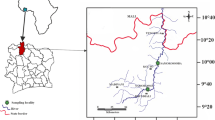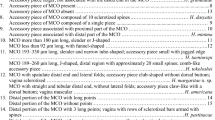Abstract
Introduction
Members of the genus Mymarothecium Kritsky, Boeger & Jégu, 1996 infect characiform fish in the Amazon River Basin. Although the Peruvian Amazon hosts rich fauna of fish, the taxonomic diversity of parasitic organisms such as Mymarothecium has been few explored. A new species of Mymarothecium in Colossoma macropomum Cuvier, from the southeast of the Peruvian Amazon, is described.
Methods
Monogeneans were isolated from gills of C. macropomum, fixed in formaldehyde in 4% solution. For morphological examinations were stained with Gomori’s trichrome and others were clarified with Hoyer’s medium.
Results
Mymarothecium is the third species of the genus recorded in C. macropomum. These new species have been characterized by a slightly sigmoid male copulatory organ (MCO) and the accessory piece with sinuous distal rod with hook-shaped process and a bifurcation in the middle part. Furthermore, the anteromedial projection of the ventral rod has a small conspicuous filament in both anchors.
Conclusions
With the description of this new species, eight species of Mymarothecium have been reported in fish of the Serrasalmidae family originating in the Amazon.

Similar content being viewed by others
References
Alcántara F, Verdi L, Murrieta G, Rodríguez L, Chu Koo F, Del Águila M (2015) Parásitos de alevinos de gamitana (Colossoma macropomum) y paco (Piaractus brachypomus) cultivados en el C.I. Quistococha, Loreto, Perú. Cienc Amazón Iquitos 5:42–49. https://doi.org/10.22386/ca.v5i1.89
Belmont-Jégu E, Domingues MV, Martins ML (2004) Notozothecium janauachensis n. sp. (Monogenoidea: Dactylogyridae) from wild and cultured tambaqui, Colossoma macropomum (Teleostei: Characidae: Serrasalminae) in Brazil. Zootaxa 736:1–8. https://doi.org/10.11646/zootaxa.736.1.1
Boeger WA, Piasecki W, Sobecka E (2002) Neotropical Monogenoidea 44. Mymarothecium viatorum sp. n. [Ancyrocephalinae] from the gills of Piaractus brachypomus [Serrasalmidae, Teleostei] captured in a warm-water canal of a power plant in Szczecin, Poland. Acta Ichthyol Piscat 2:157–162. https://doi.org/10.3750/AIP2002.32.2.06
Boeger WA, Vianna RT (2006) Monogenoidea. In: Joachim Adis, Jorge R Arias, Guillermo Rueda-Delgado, Karl Matthias Wantzen (org.). Aquatic biodiversity in Latin America, Vol. 1. Amazon fish parasites, Vernon E. Thatcher. 2nd ed. PensoftSeries faunisticas, Plön, p 42–116
Centeno L (2004) Fauna ectoparasitaria asociada a Colossoma macropomum y al híbrido de C. macropomum x P. brachypomus, Cultivados en el Estado Delta Amacuro, Venezuela. Bioagro 16:121–126
Chu-Koo FW, Alcántara F (2007) De la selva su acuicultura. sobre los avances en acuicultura en la Amazonia peruana y las oportunidades de inversión. Perú Econ 30:11–12
Cohen SC, Kohn A (2005) A new species of Mymarothecium and new host and geographical records for M. viatorum (Monogenea: Dactylogyridae), parasites of freshwater fishes in Brazil. Folia Parasitol 52:307–310. https://doi.org/10.14411/fp.2005.042
Cohen SC, Kohn A (2009) On Dactylogyridae (Monogenea) of four species of characid fishes from Brazil. Check List 5:351–356. https://doi.org/10.15560/5.2.351
Flores J, Flores CF (2003) Monogenean, parasites in Mexican fish: a recapitulation. Técn Pecuari México 41:175–192
Kritsky DC, Boeger WA, Jégu M (1996) Neotropical Monogenoidea. 28. Ancyrocephalinae (Dactylogyridae) of piranha and their relatives (Teleostei, Serrasalmidae) from Braziland French Guiana: species of Notozothecium Boeger and Kritsky, 1988, and Mymarothecium gen. n. J Helminthol Soc Wash 63:153–175
Leão MSL, Justo MCN, Bueno GW, Cohen SC, São Clemente SC (2017) Parasitism by Monogenoidea in Piaractus mesopotamicus (Characiformes, Characidae) cultivated in Paraná river (Brazil). Braz J Biol 77:787–793. https://doi.org/10.1590/1519-6984.00916
Mendoza-Franco EF, Mendoza-Palmero CA, Scholz T (2016) New species of Ameloblastella Kritsky, Mendoza-Franco & Scholz, 2000 and Cosmetocleithrum Kritsky, Thatcher & Boeger, 1986 (Monogenea: Dactylogyridae) infecting the gills of catfishes (Siluriformes) from the Peruvian Amazonia. Syst Parasitol 93:847–862. https://doi.org/10.1007/s11230-016-9671-7
Mendoza-Palmero CA, Scholz T, Mendoza-Franco EF, Kuchta R (2012) New species and geographical records of dactylogyrids (Monogenea) of catfish (Siluriformes) from the Peruvian Amazonia. J Parasitol 98:484–497. https://doi.org/10.1645/ge-2941.1
Mizelle JD (1936) New species of trematodes from the gills of Illinois fishes. Am Midl Nat 17:785–806. https://doi.org/10.2307/2420687
Mizelle JD, Kritsky DC (1967) Studies on Monogenetic Trematodes XXX. Five new species of Gyrodactylus from the pacific tomcod, Microgadus Proximus (Girard). J Parasitol 53:263–269
Morais AM, Varella AM, Villacorta MA, Malta JC (2009) A fauna de parasitos em juvenis de tambaqui Colossoma macropomum (Cuvier 1818 (Characidae: Serrasalminae) criados em tanques-rede em lago de várzea da Amazônia central. Biol Geral Exper 9:14–23
Morey GAM, Aliano AMB, Grandez FAG (2019) New species of Dactylogyridae Bychowsky, 1933 infecting the gills of Myloplus schomburgkii (Jardine) and Colossoma macropomum (Cuvier) in the Peruvian Amazon. Syst Parasitol 96(6):511–519. https://doi.org/10.1007/s11230-019-09865-9
Ramos E, Nieves Sandoval C, Siever Morales C, Guadalupe Contreras S, Alberto Manchego YS (2016) Lesiones histopatológicas y Aislamiento Bacteriológico en Gamitanas (Colossoma macropomum) Aparentemente Sanas. Rev Inv Vet Perú 27:188–195. https://doi.org/10.15381/rivep.v27i1.11460
Ribeiro-Neto TF, da Silva AHG, Guimarães IM, Gomes MVT (2016) Piscicultura familiar extensiva no baixo São Francisco no estado de Sergipe. Acta Fish Aquat Res 4:62–69. https://doi.org/10.2312/Actafish.2016.4.1.62-69
Soberon L, Mathews P, Malherios A (2014) Hematological parameters of Colossoma macropomum naturally parasitized by Anacanthorus spathulatus (Monogenea: Dactylogiridae) in fish farm in the Peruvian Amazon. Int Aquat Res 6:251–255. https://doi.org/10.1007/s40071-014-0087-1
Vargas M, Sandoval N, Casas E, Pizango GY, Manchego A (2015) Parásitos y Lesiones Histopatológicas en Branquias de Gamitanas (Colossoma macropomum) Juveniles bajo Crianza Semiintensiva. Rev Inv Vet Perú 26:577–586. https://doi.org/10.15381/rivep.v26i4.11222
Acknowledgements
We want to thank UNMSM for financing the project with internal funds with R.R. 05969-R-18 and code B18100364.
Author information
Authors and Affiliations
Corresponding author
Ethics declarations
Conflict of Interest
The authors declare that they have no conflict of interest.
Ethical Approval
This study was performed in agreement with the recommendations of all applicable institutional, national and international guidelines for the care and use of animals. Responsible research conduct was approved by the National Council for Science, Technology and Technological Innovation (CONCYTEC). Number of the ethical protocol: No. 023-2016-AQUAREC-IIAP-MDD/JGBM.
Additional information
Publisher's Note
Springer Nature remains neutral with regard to jurisdictional claims in published maps and institutional affiliations.
Rights and permissions
About this article
Cite this article
Cayulla-Quispe, D., Mondragón-Martínez, A., Rojas-De-Los-Santos, E. et al. A New Species of Mymarothecium tantaliani n. sp (Monogenea: Dactylogiridae) in the Gills of Gamitana Colossoma macropomum (Cuvier) from Madre de Dios, Peru. Acta Parasit. 66, 34–38 (2021). https://doi.org/10.1007/s11686-020-00248-5
Received:
Accepted:
Published:
Issue Date:
DOI: https://doi.org/10.1007/s11686-020-00248-5




